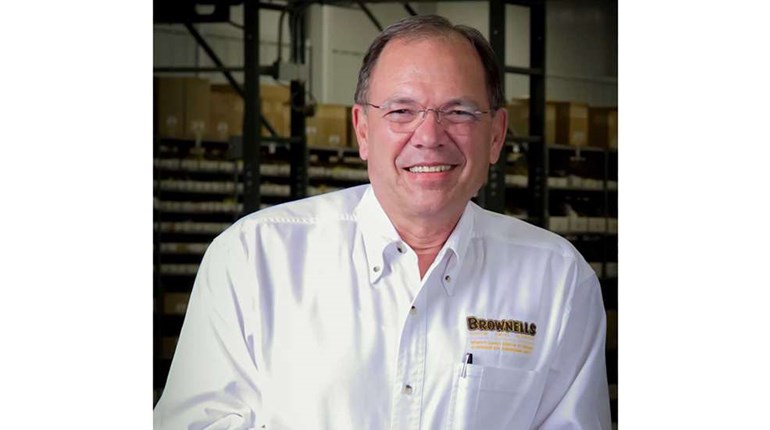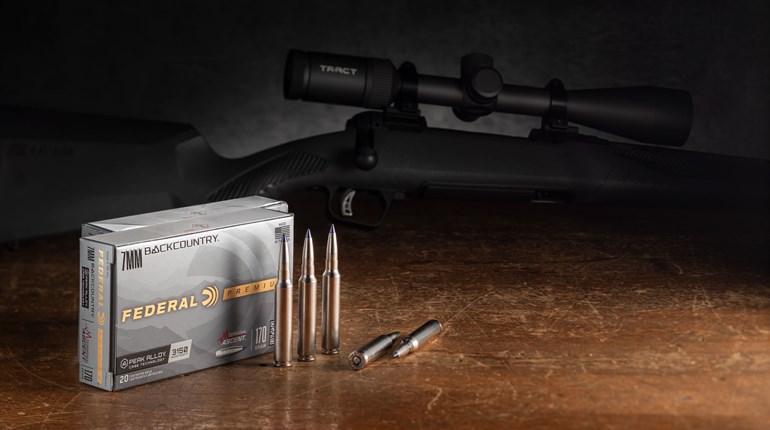
We may not always be able to articulate it, but there resides within us all a deep-seated appreciation for the land. Hunters know where their food comes from; there is no denying that. We learn this every time we bring a bird to hand or walk up on a freshly killed deer, when we gaze at the animal and scan the landscape and give thanks, knowing Earth has once again provided.
Hunters are perhaps overshadowed in this knowledge only by farmers and ranchers. Clearly, the men and women who grow our food know intrinsically that Earth provides. But in my experience not every farmer or rancher is a hunter. Oh, many are; don’t get me wrong. But not all of them, perhaps because a rancher knows beef tastes better than any deer. Besides, farmers and ranchers are busy folks. Given this, it’s nice to come across a farmer who hunts.
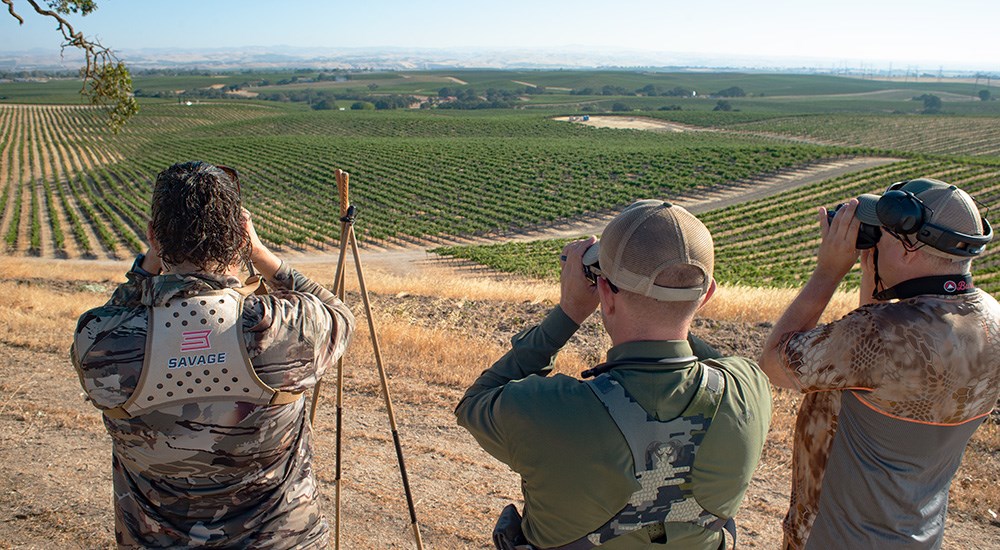
That’s exactly what happened last August when I joined two other hunters in Paso Robles, Calif., to hunt deer with Savage’s newest rifle, the Impulse Mountain Hunter, at Steinbeck Vineyards. No, this wasn’t a mountain hunt, but we didn’t care. We’d all heard about Steinbeck and we all were eager to hunt there. It’s true Steinbeck hunts have been covered in these pages before, more than once in fact. But I didn’t care when I accepted the invitation. I knew about the Steinbeck story, and I jumped at the chance to cover it myself.
You see I think any hunt is made better if it takes place on land that has a story, and it involves wine. Yep, I love wine. I love drinking it, of course, but I also love learning about how and where it is made. Grape growing and winemaking is tied to the land. Visits with people who grow grapes and make wine have taught me that.
And make no mistake Earth lies at the heart of every glass of wine. It’s what’s meant when winemakers speak of terroir, a French term that refers to the complete natural environment in which a particular wine is made, such as soil, topography and climate. Terroir imparts a characteristic taste to wine. As someone who has visited many vineyards across the country and someone who is a wine club member, I knew this. But as I said I also knew the Steinbeck story, which ties all this together.
■ ■ ■
The first morning three of us climbed into a pickup with Steinbeck’s Ryan Newkirk before dawn. The cool air reminded me we weren’t far from the Pacific, but I knew I’d be peeling layers before long. It was August, after all.
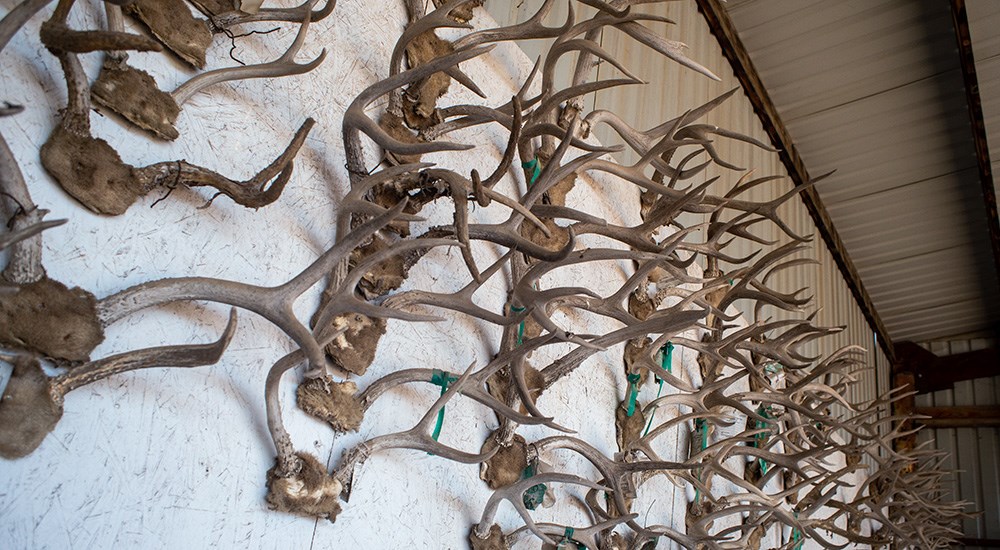 Hunting is and always has been a thing at the Steinbeck farm. Years upon years of deer racks nailed to a wall inside a machine shop testify to that.
Hunting is and always has been a thing at the Steinbeck farm. Years upon years of deer racks nailed to a wall inside a machine shop testify to that.
I was up first, so I sat co-pilot. In back was Eric Poole, who used to work for NRA Publications as our firearm inventory manager. He left us for another job then became editor in chief of Guns & Ammo magazine. Like me, Eric is also a former Marine. Alongside him was Beth Shimanski, marketing manager at Savage and our host for this trip. Beth is from Minnesota and sincerely loves the outdoors.
As we motored away from the vineyard headquarters, Ryan gave us the rundown.
The Steinbeck property is 500 acres; 400 acres are in grapes. We were hunting Columbian blacktails, which may be found here in some of the riparian areas of the farm or among the oaks but mostly live among the grapes. The vines are watered through drip irrigation. Every other year, workers clear every other row between the vines to prevent competition for the water. Around here water is a valuable commodity. Land without it pales in value compared to the ground beneath us. Here the deer live the life of Reilly. In the heat of the day they lounge beneath the grape vines. They bow their heads and sip water from the puddles at the base of every vine and when they’re hungry the reach up and pluck off some grapes. They really have no reason to move.
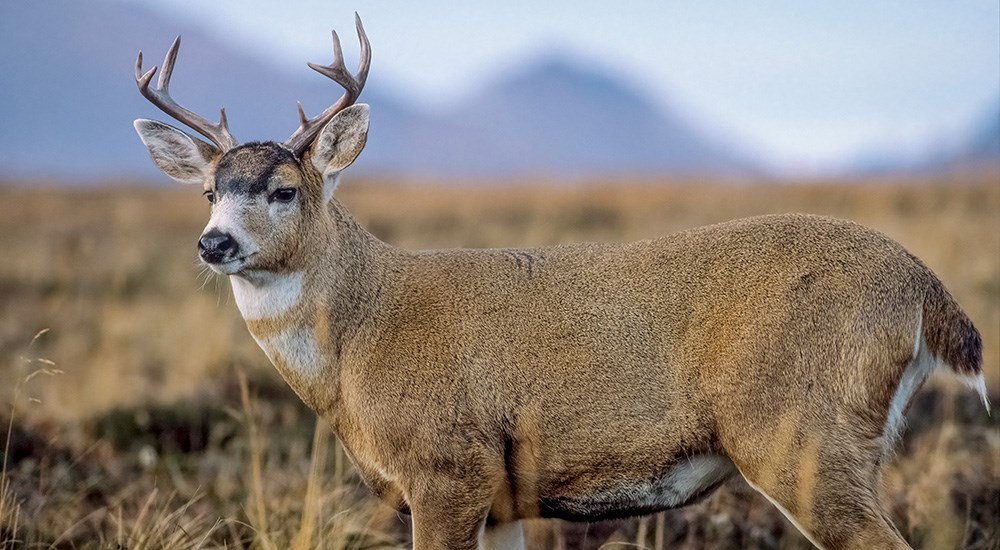
The vineyard is teeming with deer, the result of good farming practices and Ryan’s management of them via hunting. He doesn’t really take enough deer off the land, though. Each year Ryan guides perhaps half a dozen folks like me, thanks to a connection he’s made with the shooting-and-hunting industry. His family and friends take a half-dozen more deer, and that’s it. He really could use some depredation permits to thin out the doe segment of the deer population, but fish-and-game does not issue them. Says Ryan: “One guy asked me, ‘Have you thought about high fences?’” In the dark in the cab of the truck three of us shake our heads. As hunters we know this is not a good idea. A high fence would create a sterile landscape. It would merely displace fauna, not help it. That’s not good for anyone. Hunting is best to try to keep some balance here.
There is really no way to hunt these deer by foot, Ryan warns us. One can try, but a hunter afoot is apt to bump deer and never get a shot. I suppose you could sit somewhere and wait. But I imagine that would be like hunting pronghorn over a waterhole: You may sit there all day and finish a novel before seeing a quality buck appear. Better is to putter around in the pickup, something the game is used to seeing. If we see a buck we like we will glass him, survey the topography and make a plan. Then we’ll motor away and sneak back on foot. If all goes well, Ryan will throw up the shooting sticks and we will shoot standing with a rest, Africa-style. Shots may range from 40 yards to a couple of hundred.
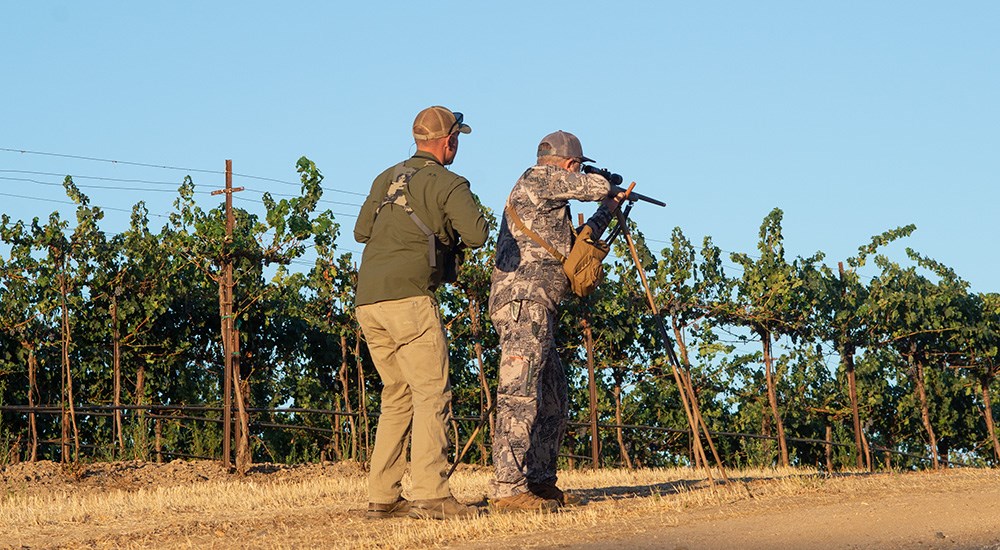
“I’ll pull forward and we can get out and sneak back to this row,” said Ryan when he settled on a buck lying with a group of deer in a row of grapes. He nudged the truck forward but I had other thoughts.
“Heck,” I replied, “just back up and I’ll slide out the passenger side and I’ll sneak around the back of the truck and up to the rows. Then I’ll low-crawl up to that row and shoot him from the prone.”
So that’s what I did, but I didn’t exactly execute a very good low-crawl. Hey, I’m old. But the plan worked, mostly, for by the time I settled in behind the gun the buck was getting antsy, and looking at me. He stood and faced me, bobbed his head then moved to my right, ducked beneath the grapevines and crossed to the next row. No shot. I took the time to build a better shooting position. I could see his legs beneath the vines 150 yards away. He wasn’t going anywhere. I settled in behind the gun, got good and comfortable with my prone position and waited.
I watched the buck through the scope and kept tabs on the rest of the group through my left eye. No one was moving much. I expected everything to go back to normal momentarily …
And it did. The buck ducked and stepped back into my row. He turned and stepped uphill then stood for a heartbeat, quartering away from me and blam—I fired. The buck took two more steps and collapsed beneath the same row of grapes he was lounging under when we found him.
As we disposed of the buck’s innards at the dump on the farm, Ryan quipped, “We have a slogan here: wine by 9.” I chuckled, checked my watch and said, “We’ve got time; we can make it.” I didn’t know it, but he was serious.
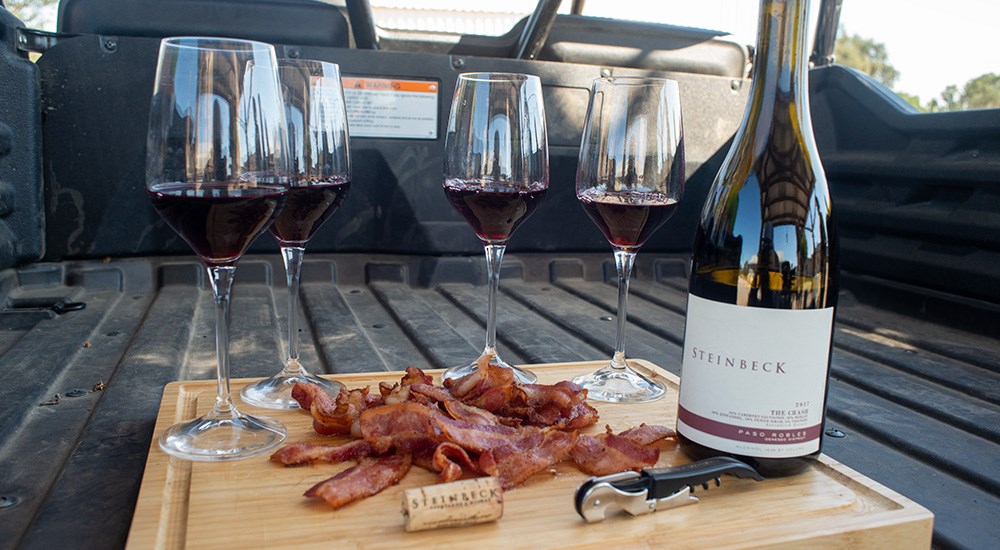
We hung the deer by its legs from the meat pole beneath the roof of the skinning shack, just across a dusty lot from the winery’s tasting room. Not long afterward Ryan’s mom, Cindy Steinbeck, brought us a plate of bacon and a bottle of wine. When Ryan pulled the hide from the buck it wasn’t hard to find my bullet, a Hornady CX(Copper alloy eXpanding), a reminder that we were hunting in the California condor zone. But why call it that, really? These days, all of California is the condor zone, and a nontoxic bullet is the only kind you may use here.
With a bottle of Steinbeck’s signature wine, The Crash, vintage 2017, we toasted my deer, the vineyard and good fellowship.
■ ■ ■
Ryan Newkirk is the seventh generation of his family to love this land along California’s Central Coast.
These days the patriarch is Howie Steinbeck, a member of the fifth generation. His great-grandparents, the Ernsts, moved here from Geneseo, Ill., and named a nearby town the same, in 1884. On that ground they planted 25 varieties of grapes for making wine, taking cuttings from a University of California-Davis experimental project in 1900. Howie’s grandparents on his mother’s side, Frank and Rosie Ernst, purchased what is now Steinbeck Vineyards in 1921. They built the ranch home and the old barn, and in 1948 they built the blacksmith shop, now used as the tasting room. Exploration of a machine shed behind the tasting room reveals generations of deer racks nailed to the wall.
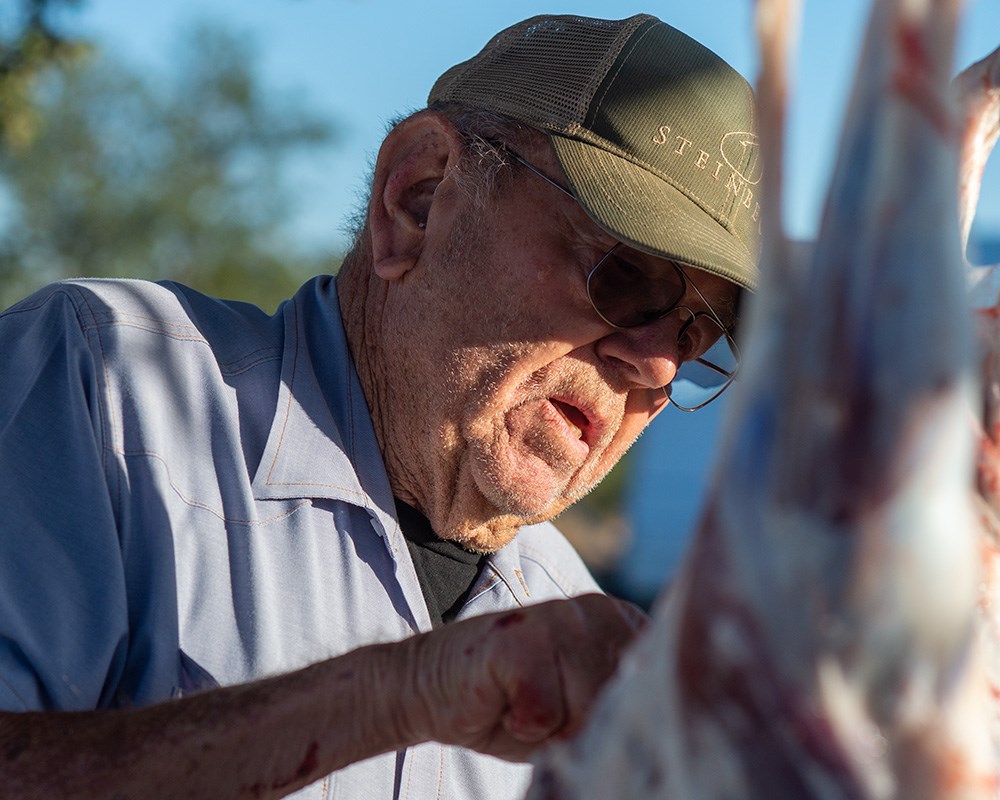 Howie Steinbeck grew up here and planted his first 50 acres of grapes in 1982. He has taken many deer in the vineyard with his old Savage.
Howie Steinbeck grew up here and planted his first 50 acres of grapes in 1982. He has taken many deer in the vineyard with his old Savage.
Howie met his wife, Beverly, in high school. Here they raised four children who have produced seven grandchildren. Howie has been a leader in viticulture in Paso Robles since 1970. As I understand it, he was the first farmer in the Paso Robles area to plant grapes, back in 1982. Until then everyone in this region grew staples like barley, but by the early ’80s that just wasn’t paying, Howie says. He planted his first 50 acres in grapes in 1982, and Steinbeck Vineyards was born. Some of those Cabernet Sauvignon vines still stand today.
Howie’s daughter, Cindy, moved back home in 1997 following a career in family life ministry to help with the Steinbeck growing business. She created Steinbeck Vineyards and Winery in 2006. Cindy’s son, Ryan, always knew he wanted to work alongside his granddad. Today, with a degree from Cal State-Fresno, he is operations manager at Steinbeck, living nearby with his wife and children. Visitors can’t help but develop a kinship with the family and its connection to the land via interpretive displays on the walls of the tasting room, or through Cindy’s Crash Courses via Jeep in the vineyard.
Steinbeck is a boutique winemaker, by California standards. Most of the grapes they grow here are sold to other winemakers. With what the family keeps they make excellent wine. Today Howie still likes to hunt. If you’re lucky he might even skin your buck for you, and you’ll be able to quiz him about his life and what it was like to grow up here. We were and we did.

Perhaps the most poignant story is how Steinbeck named its signature wine.
In 1956, Howie was a senior in high school when his parents called him home. A plane had crashed less than 200 yards from the ranch house; he was needed to help with recovery efforts. A B-26 was en route from Biggs Air Force Base in Texas to Mather AFB near Sacramento when its instruments were rendered useless in a storm off the coast. Running low on fuel, the pilot gained altitude and ordered the crew to bail out. Later the pilot bailed, too. He parachuted to safety, as did three other crewmembers. But one fellow was not so lucky. Sergeant Fred Kilby did not eject safely, and he died, tragically.
In 2006, when the Steinbeck family wanted to create a signature wine, Howie thought of the crash. He tracked down the only two living survivors, 1st Lt. Robert Nilsson, then 76 and living in Utah, and Staff Sgt. O.J. Fazio, then 86 and living in Massachusetts. Howie and Bev traveled to each state to meet each man, and Howie and the men recalled that fateful day. Howie and Bev also put the survivors in touch with one another. It seems that shortly after the crash the men lost contact and had not spoken in 53 years. Each of them graciously agreed that a special wine like The Crash respectfully commemorated their military service and sacrifice.
■ ■ ■
All of that is why many people say the best way to see a place is to hunt it. If you pay attention you learn all sorts of things about the land and its history, the people who live on it and work it, the flora and fauna that grow on it.
By the end of three days all three of us had taken not only three deer but we’d opened at least three bottles of wine to toast our trophies. Actually, we opened more than three bottles, but those other corks were pulled after shooting hours. Beth salvaged some staves from an old wine barrel to create a handsome wall display for her buck’s rack—not a bad idea. We all joined the Steinbeck Wine Club. As I write this I anxiously await my first shipment, which will include the latest vintage of The Crash, naturally.
Finally, to answer your question: Yes, the vineyard venison is delicious, and why not? Steinbeck deer live and die beneath some of the tastiest carbohydrates imaginable. It was late August when we skinned those bucks, and every one of them was covered with a thick layer of fat, a testament to the diet the deer enjoy. I am convinced this deer from California’s Central Coast tastes as sweet as the grapes that nurtured it. Can you use terroir to speak of venison? I guess I just did.
Savage Impulse Mountain Hunter
In California, we carried the newest version of the Savage Impulse, called the Mountain Hunter.
The Impulse is American Hunter’s 2022 Rifle of the Year. It’s a straight-pull bolt action built on an aluminum receiver with Savage’s patented Hexlock system. In it, six ball bearings surround the bolt head; when the bolt is pushed home, the mechanism locks the bearings into a machined recess in the barrel extension. When a round is fired, the pressure increase tightens the bearings to lock smartly. Then, pulling back on the bolt releases the plunger, unlocking the bearings. Savage’s marvelous AccuTrigger makes for marvelous groups. It’s adjustable from 1.5-4 pounds’ pull.

A Proof Research carbon fiber-wrapped stainless steel barrel is the standout feature on the Mountain Hunter. It’s fat and fills up the barrel channel of the stock nicely. It’s matte gray and runs 22 to 24 inches long depending on caliber. The muzzle is threaded ⅝x24 and comes fitted with a brake.
The gray AccuStock complements the gray metalwork. With its AccuFit system, length of pull is adjustable from 12.75-13.75 inches, and interchangeable cheekpieces allow a hunter to create a custom fit on the comb behind a riflescope.
In any caliber, overall length is kept to about 45 inches, and weight never tops 7.3 pounds. The Mountain Hunter is chambered in seven cartridges including 6.5 Creedmoor, which I shot in California, 6.5 PRC, .308 Win., 28 Nosler, 300 WSM, .300 Win. Mag. and 7mm PRC. This is one heckuva rifle; it just feels good in my hands—and like any Savage it shoots! I learned the morning I took my deer that I was the first hunter to take game with a Mountain Hunter.













